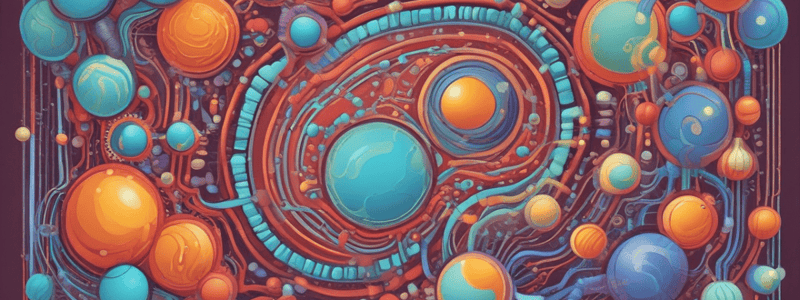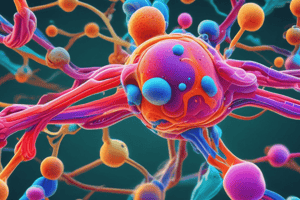Podcast
Questions and Answers
What is the primary mechanism of substrate-level phosphorylation?
What is the primary mechanism of substrate-level phosphorylation?
- Direct transfer of a phosphate group from a phosphorylated compound to ADP (correct)
- Redox reactions within the mitochondria
- Transfer of energy from electron transport chains
- Conversion of light energy into chemical energy
During which stage of cellular respiration does oxidative phosphorylation occur?
During which stage of cellular respiration does oxidative phosphorylation occur?
- Fermentation
- Pyruvate oxidation
- Final phase of cellular respiration (correct)
- Glycolysis
In which organelles does photophosphorylation occur?
In which organelles does photophosphorylation occur?
- Lysosomes
- Chloroplasts (correct)
- Endoplasmic reticulum
- Mitochondria
What is the byproduct of substrate-level phosphorylation during glycolysis?
What is the byproduct of substrate-level phosphorylation during glycolysis?
Which type of phosphorylation reaction does not involve the transfer of energy from electron transport chains?
Which type of phosphorylation reaction does not involve the transfer of energy from electron transport chains?
What is the principal difference between substrate-level phosphorylation and oxidative phosphorylation?
What is the principal difference between substrate-level phosphorylation and oxidative phosphorylation?
Which type of phosphorylation reaction is most closely associated with the light-dependent reactions of photosynthesis?
Which type of phosphorylation reaction is most closely associated with the light-dependent reactions of photosynthesis?
What is the primary role of the electron transport chain in oxidative phosphorylation?
What is the primary role of the electron transport chain in oxidative phosphorylation?
In which metabolic process is substrate-level phosphorylation most commonly observed?
In which metabolic process is substrate-level phosphorylation most commonly observed?
What is the characteristic shared by substrate-level phosphorylation and photophosphorylation?
What is the characteristic shared by substrate-level phosphorylation and photophosphorylation?
Flashcards are hidden until you start studying
Study Notes
Phosphorylation Reactions that Generate ATP
- Substrate-level phosphorylation: Direct transfer of a phosphate group from a phosphorylated compound (substrate) to ADP to form ATP.
- Occurs during glycolysis
- Example: Phosphate group transfer from phosphoenolpyruvate (PEP) to ADP to form pyruvate and ATP
Oxidative Phosphorylation
- Production of ATP using energy derived from redox reactions of an electron transport chain
- Final phase of cellular respiration
- Occurs in the mitochondria of eukaryotic cells
- Example: ATP generated during aerobic respiration
Photophosphorylation
- ATP formation using energy from sunlight in photosynthesis
- Occurs in the chloroplasts of plants
- Example: Light energy conversion into chemical energy during light reactions of photosynthesis
Studying That Suits You
Use AI to generate personalized quizzes and flashcards to suit your learning preferences.




